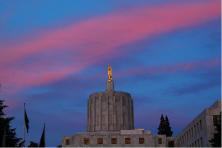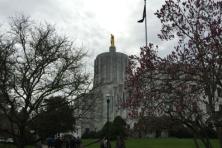Last month, Oregon Governor Kate Brown took one of the most important climate actions of her governorship, signing an executive order calling for greater energy efficiency in newly constructed buildings. Executive Order 17-20 has the potential to significantly reduce climate pollution from Oregon’s building sector and save Oregonians hundreds of millions of dollars.
Buildings account for roughly one third of Oregon’s climate pollution, second only to transportation as the largest emission sector. So it is essential that we increase energy efficiency to reduce emissions in homes, offices, and other buildings.
This action could have a major climate impact. Approximately 40 percent of the Portland Metro area’s residential and commercial buildings will be built over the next thirty years, and it is estimated that 700,000 new homes and apartments and 800 million new square feet of commercial building space will be built in Oregon by 2050. Achieving significant increases in energy efficiency in the construction of these buildings could save up to 6.3 million metric tons of carbon pollution by 2050, equivalent to eliminating the energy use of 665,000 homes for a year.
As I discussed in another blog post last year, Oregon has a well-earned reputation for leadership in green building, and regularly scores in the top tier of states for LEED certified construction. However, Oregon has fallen behind the leadership curve on minimum energy efficiency standards in its statewide building codes for both residential and commercial construction. Oregon’s energy efficiency standards have been at risk of falling behind even the minimum required federal standards. Improving these building codes provides the most cost effective reduction in carbon pollution we can obtain in the coming decades.
Things began to change last year, when the Oregon Building Code Division updated the standard for homes to achieve a 9 percent increase in energy efficiency. This important victory happened in response to sustained advocacy from Climate Solutions and numerous partners and stakeholders including Earth Advantage, New Building Institute, and Northwest Energy Coalition, as well as legislative leadership from Representative Ken Helm, Chair of the House Energy and Environment Committee.
The Executive Order calls for residential buildings to be improved 20 percent over six years, achieving an almost a 30 percent cumulative improvement including the increase approved last year by the state agency. It also calls for commercial buildings to be improved by 24 percent over six years, and further requires commercial buildings at a minimum meet the leading energy efficiency model code standards. Once implemented, these improvements will put Oregon back among the leading states for energy efficiency in the residential and commercial sectors in the United States.
Climate Solutions and several partners have formed the Net Zero Energy Buildings Coalition to support implementation of the executive order and advance the rapid adoption of zero energy building standards. The Coalition will work over the coming years to: (1) advocate with the Building Codes Division and its relevant advisory boards to stay on this course to zero energy buildings; and (2) educate the public and the building sector of the huge benefits to home and building owners of increased energy efficiency in construction.
We’re very excited about these wins for Oregon. These improvements to new buildings in the state will save people money on utility bills, improve air quality and comfort at home and work, and make a big difference in reducing the building sector’s contribution to the climate crisis.





